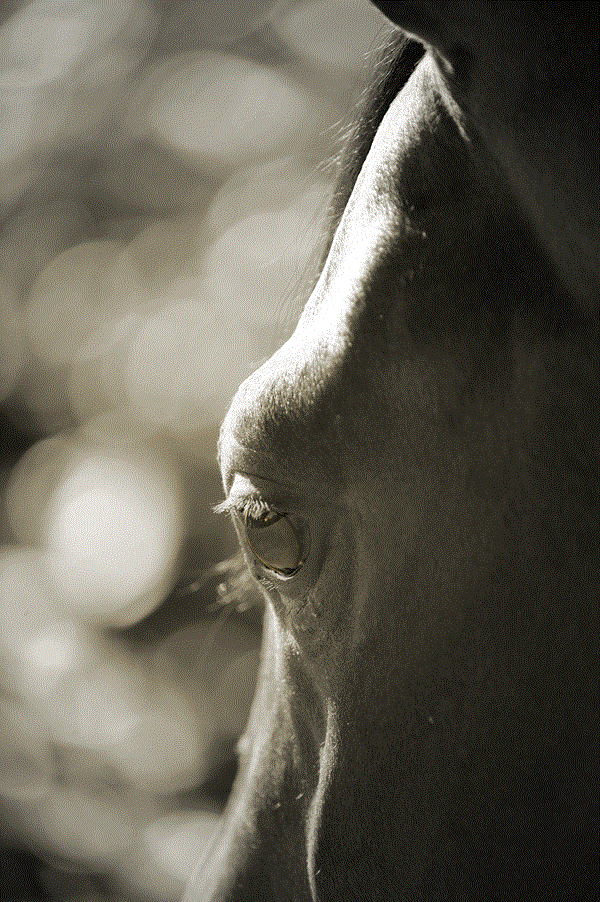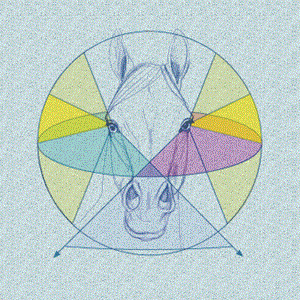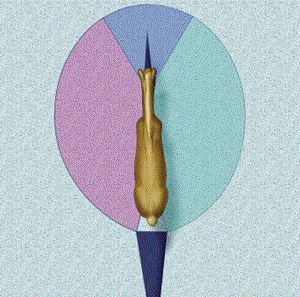You’ve probably witnessed this scene during television coverage of equestrian events, or at a horse show: Horse and rider gallop up to an imposing jump. Within a few strides of the obstacle, the rider tenses slightly; the horse rocks his weight back over his hindquarters in preparation for takeoff. All looks good…until the horse abruptly slams on the brakes at the jump’s base, and the force hurtles his rider through the air and into the jump.
[READ: Horse Blindness Solutions]

Is the horse being mean? Stubborn? Probably not. Odds are, if you saw what he saw on his approach to the fence (or what your own horse will see when he jumps a ditch or a fallen log, or crosses a trail obstacle), you’d stop, too. That’s because just as a horse reaches his takeoff point, the obstacle in front of him disappears, entering a cone-shaped blind spot that extends about 4 feet in front of his face. For your horse to go over any obstacle, it requires a leap of faith—faith in your ability to safely guide him over it, and faith in his ability to safely negotiate it. If you do anything to rattle that faith, as the rider in the above scenario did (by tensing up), chances are, your horse won’t take the leap.
The disappearing obstacle is just one of the ways your horse’s vision differs—radically—from yours. To help you gain a horse-eye view of the world, I’m going to take you on a short ride, comparing what you see, against what research tells us your horse sees. By the end of our ride, you’ll find that viewing the world through your horse’s eyes will open a window to equine behavior.
You’ll have a better understanding of why your horse spooks at “invisible” demons; why objects that look harmless to you send him flying sideways; and why he often reacts to things as though he’s viewing them for the first time, even though you know he’s seen them before. You’ll also realize why it’s truly amazing when your horse does do something you ask of him, such as walk calmly into your horse trailer, or trot past that big tree stump.
THE INCREDIBLE JOURNEY
Journey with me, as we ride down a several-100-yards-long dirt driveway. Along the way, we’ll pass sights common to every barnyard. With each, I’ll describe what you’ll see, and then will explain your horse’s view of the same sight.
The Gate Has Arms
What you see: Just ahead, there’s a 14-foot-wide gated opening through which we must pass to reach the end of the driveway. In preparation for our ride, I opened the aluminum gate earlier; you see it propped up on the grass beside my driveway, shimmering in the bright sun.
Why you see it that way: Your eyes are on the front of your face, and working together, they bring your brain a simultaneous, 3-D image. This phenomenon, known as binocular vision, is indigenous to predators, which, like cats, dogs, cougars, wolves, etc., we humans are. Nature designed binocular vision to enable predators to chase down, catch, and kill prey darting in front of them.
Your focusing apparatus works like that of an auto-focus camera. Your eyes automatically focus on the gate, using flexible disc-like lenses that are attached to powerful ciliary muscles. These muscles instantly flex or relax as needed to adjust your lens shape, so you can send a sharp image to your retina, the “switchboard” of nerve receptors on the back wall of your eyeballs. This switchboard then relays the picture to your brain.
Your reaction: You approach the open gate without giving it another thought.
What your horse sees: To him, the gate appears to be a hologram—a collage of silver arms, shimmering into and out of focus, reaching forward and back as he approaches and passes it.
Why he sees it that way: As a prey animal, your horse has monocular vision, meaning he has one eye on each side of his head. A prey animal’s eyes work independently of one another, sending separate images to separate sides of his brain as they constantly search for predators lying in wait. Only when your horse has directed both eyes on an object directly in front of him—beyond his front-end blind spot—do both eyes focus together in binocular vision.
Regardless of whether he’s eyeing the gate—or any other up-close object—using one eye or both, your horse’s lenses are much less flexible than yours. His poorly developed ciliary muscles are ill-equipped to make more than small, slow adjustments—much too small, and much too slow to allow him to make quick, informed decisions visually. (Which is why Mother Nature has programmed him to first flee to safety, then to check out the situation from a safe distance.) To help his eyes focus in spite of rigid lenses, he must move his head, adjusting the distance—known as focal length—between his eye or eyes and the gate, and adjusting the angle of view, until the image falls into focus on the appropriate portion of his retina.
As he moves through the opening, portions of the gate move into focus, while other portions seem to be shimmering blurs that change as his every step and minor head movement alter the focal length and angle of view. To your horse, this appears as though portions of the gate are actually moving—an unsettling vision for a prey animal who believes that strange, moving objects are boogiemen until proven otherwise, and are to be approached with the utmost caution, if at all.
His reaction: He raises his head for an up-close look through the lower half of his eyeballs (more about that later); then cautiously steps through the opening.
Kitty Kong

What you see: My 10-pound yellow cat sitting on a stump to the right of my driveway.
Why you see it that way: Your eyes’ auto-focus mechanism instantly sends your retina a sharp image of the cat.
Your reaction: “What an adorable kitty!”
What your horse sees: A cat the size of a Cocker Spaniel.
Why he sees it that way: Your horse’s eyeball is the largest orb found in any land mammal, and has a correspondingly oversized retina. The effect of this large retina is that it magnifies everything he sees—to him, up-close objects look 50 percent larger than they appear to you.
His reaction: Yikes! Kitty’s larger-than-life appearance ensures that your defenseless equine will be less apt to be surprised by a predator. While this feature keeps him on his toes (sometimes literally!) toward danger, it also makes for a lot of false alarms.
Oh, Deer
What you see: As we top a slight hill, you spot a couple of white-tail deer 50 yards below and to your left, grazing in front of a stand of trees.
Why you see it that way: As we top the hill, you turn your head slightly leftward so that the deer remain directly in your binocular line of vision. But, as you turn your attention back to the driveway, to make your way down the backside of the hill, the deer fall into your peripheral vision, the area just outside the line of direct sight; they become a fuzzy clump of tan blobs off to your left.
Your reaction: Once the deer fall out of your front-line vision, you stop paying attention.
What your horse sees: This depends on his position on the hill. He may not even notice the deer as he crests it, since they’re slightly ahead and to the left of him, at a level lower than his head. As he passes over the hilltop, and begins to walk down the other side, the deer enter his peripheral vision—and become crisp, sharp images.
Why he sees them that way: He can’t clearly see them from the hilltop, because his eyes operate in a manner similar to bifocal glasses. Looking through the lower half of his eyes—as he would be at the deer below—he can clearly see up-close objects, but not those in the distance. Looking through the upper half of his eye, he can clearly see distant objects, but not those up close.
In your horse’s peripheral vision, the deer come into sharp focus, because images viewed in a 215-degree area spanning each side of him fall into a portion of his eye known as the “visual streak.” This streak is a horizontal band just above and to the outside of his eyes’ center. (See diagram, above.) It’s across this area that your horse’s vision is sharpest, due to the density of nerve cells that receive visual information at the site. The result is superb peripheral vision, an imperative survival tool that helps him constantly monitor his environment for predators lurking on either side of or behind him.
Using this vision, he’s genetically programmed to pick up slight, invisible-to-you movements. The fluttering of a wing, the flick of a branch, the blink of a predator’s eye—these happenings, slight or invisible to the human eye, are big-screen occurrences to your horse. Even if he can’t quickly focus on what moved, the abundance of specialized receptors within his retinas give him keen motion detection, putting him on instant alert. His survival instincts scream that a predatory attack could be imminent, and he must be ready to flee at any moment. Subtle movement may elicit no more than a turn of his head or a slight spook; a larger commotion could trigger his flight instinct—run first, think about it later.
His reaction: As long as the deer are quietly grazing, your horse will likely take them in stride. But, if they were to suddenly bolt into the woods—which you can’t see because they’re out of range of your peripheral vision—your horse spooks. Silly horse, you think, as you quietly circle him to regain control, all the while looking around, trying to determine what on earth could have frightened him.
Herd Work
What you see: The sight of my German Shepherd, trotting in from the field to join our trail ride. You shift in your saddle so you can watch the dog make a beeline for your horse’s heels. He zigzags from right to left, “herding” your horse.
Why you see it that way: Your “front-of-the-face” eye placement prompts you to turn around for a full view to better analyze the situation.
Your reaction: Convinced that the dog’s herding is harmless, you turn around and face forward.
What your horse sees: His right eye sees a pony-sized dog. The dog then disappears, and another pony-sized dog appears in his left eye’s field of vision.
Why he sees it that way: Your horse’s bulging, side-of-the-head eye placement gives him a broad range of vision, which includes the ability to see behind him (as he takes in some of your in-the-saddle movements), except for an 8-foot-long cone-shaped blind spot directly behind his hindquarters, into which my dog keeps disappearing. (However, with a slight tilt of his head to either side, your horse is able to eliminate this blind spot.)
And, because your horse has monocular vision, the area in his right eye’s field of vision is perceived and processed by his brain separately from the area in his left eye’s field of vision. The unfortunate side effect of this unique ability is that while the right side of his brain has already “seen” the dog, the left side of his brain will perceive a new threat when it sees the dog.
His reaction: Because your horse must see an image with both sides of his brain before determining whether it’s friend or foe, viewing objects with one eye doesn’t adequately acclimate him to them. He’s now familiar with the dog, but when we head back up the driveway, your horse acts as though he’s walking it for the first time. And, to each side of the brain, he is!
Howdy, Neighbor

What you see: My neighbor, standing ahead of us at the end of the driveway, wearing a Panama hat with a hot-pink hatband, a brown-and-yellow striped pullover shirt, and a pair of unsightly, bilious-green stretch pants.
Why you see it that way: Because you see the world in a wide palette of colors, your neighbor’s fashion faux-paus leaps out at you.
Your reaction: Your secretly wish you were colorblind!
What your horse sees: A large human with green legs, a yellow and gray-toned body, and a brown/gray straw-looking thing on her head, which may or may not be edible.
Why he sees it that way: Your horse can perceive some colors: The most vivid to his eyes are yellow, followed by green, then blue. Researchers believe that color perception in horses helps them find food—mix the colors yellow and green, and you get the colors of spring grass; add a little blue, and you get clover or alfalfa. Since brilliant colors aren’t important for your horse’s reproduction (as they are for other species like birds and monkeys), and his predators tend to be of the brown variety, the color red isn’t imperative for his survival. He sees red as brown/gray, or as a non-color.
His reaction: Your horse isn’t frightened by bright colors—or bad taste. So long as my neighbor doesn’t make any sudden, startling movements, he’ll quietly accept her presence.
Gazing Grazer
What you see: My fashion-impaired neighbor offering us a piece of pie while motioning to a small, grassy paddock where we can put our horses.
Why you see it that way: Your eyes work as one (though they often partner with your stomach).
Your reaction: You untack your horse, turn him loose in the paddock, and chow down on a helping of fresh peach pie.
What your horse sees: Grass. He immediately drops his head, and digs in.
Why he sees it that way: Since he was designed to feed himself by grazing, he readily identifies food at ground level.
His reaction: Unless something catches his eye, he’ll probably munch away. While grazing, your horse remains aware of his surroundings to detect potential threats by looking through the tops of his bifocal eyes. If he perceives anything warranting closer examination, he’ll raise his head and arch his neck, so he can continue to use the top halfs of his eyes. He’ll then zoom in on the suspicious object with his binocular vision, phasing out any distracting peripheral scenes.
After Dark
What you see: Dusk settling in, dimming your ability to discern shapes, or see long distances.
Why you see it that way: Your eyes are poorly designed for night vision, because they lack the light absorbing/reflecting mechanisms necessary to see clearly in dim light.
Your reaction: You hurry to finish your pie, re-tack your horse, and head back up the driveway, hoping to return to the barn before total darkness descends.
What your horse sees: Head-back-home images that look brand new to each side of his brain—images he can see clearly, despite the lack of light.
Why he sees them that way: Due to the low-light perceiving receptors in his eyes, your horse’s night vision is about 50 percent better than yours. He also benefits from reflective panels on his retinas that catch the small amount of light still available at night. These panels reflect light back through his retinas for processing. (The light that bounces back out of his eyes accounts for the ghostly glowing orbs you see when a light hits his eyes at night, or in photos taken with a flash.)
His reaction: He’ll probably stroll homeward completely at ease. Because your horse can see well at night when there are usually fewer activities to clutter his constant search for danger, he’ll likely be less spooky than at high noon—unless you’re nervous, which you can easily transmit to him.






